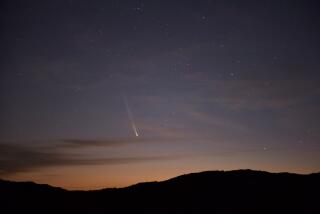Keeping an Eye on Halley’s Comet
- Share via
The 100-inch telescope on Mt. Wilson above Pasadena was once one of the world’s great astronomical instruments. Edwin Hubble used it in the 1920s to make two fundamental discoveries: that the universe is expanding, and that it contains billions of other galaxies just like ours. But light pollution from Los Angeles seriously degraded the telescope’s ability to peer into deep space.Last year the Carnegie Institution of Washington, which owns and runs the Mt. Wilson Observatory, announced that the 100-inch telescope would close on July 1, two months from now. The Carnegie Institution intends to concentrate its resources on newer telescopes that it owns at Las Campanas in Chile, where the night sky is pitch dark.
Later this year Halley’s comet will return to the neighborhood of the Earth after its 76-year peregrination through space. The comet and its tail are expected to be visible to the naked eye next spring, though the comet will be farther from Earth than it was in 1910, the last time it appeared, and it is not expected to be as spectacular in the sky as it was then.
Ben Mayer, an enthusiastic and indefatigable amateur astronomer in Bel Air, had an idea. Wouldn’t it be wonderful, he thought, if the Mt. Wilson telescope could be kept open just one year longer to give people an opportunity to look at Halley’s comet close up? Individuals could view the comet through the telescope, and TV cameras could be hooked up to it to beam pictures around the country or around the world as Halley’s makes its nearest approach to Earth.
Later this week George W. Preston, director of the Mt. Wilson and Las Campanas observatories, will meet in Washington with James D. Ebert, president of the Carnegie Institution, to discuss Mayer’s proposal. They haven’t ruled it out. “There is a possible opportunity to observe Halley’s comet here, and it’s worth at least talking about,” Ray Bowers, a spokesman for the Carnegie Institution, said Monday from Washington.
It sounds like an excellent idea, and it would be a fitting cap to the telescope’s 66-year career. It remains a superb instrument for observing nearby stars. Though some astronomers have debated the wisdom of closing it, the end of the Mt. Wilson Observatory (which also includes a 60-inch telescope and three solar towers) seems inevitable. But if it keeps going for just one more year, the telescope will provide a valuable service by bringing astronomy to the public.
The Carnegie Institution should be encouraged to make Mt. Wilson a central point for viewing Halley’s comet.






